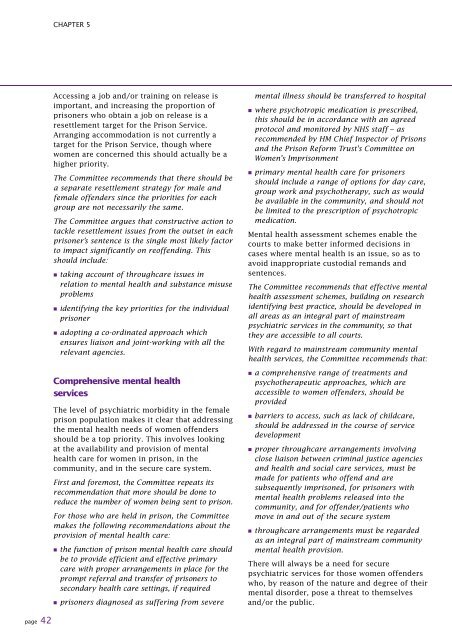Women who challenge - Nacro
Women who challenge - Nacro
Women who challenge - Nacro
- No tags were found...
You also want an ePaper? Increase the reach of your titles
YUMPU automatically turns print PDFs into web optimized ePapers that Google loves.
CHAPTER 5Accessing a job and/or training on release isimportant, and increasing the proportion ofprisoners <strong>who</strong> obtain a job on release is aresettlement target for the Prison Service.Arranging accommodation is not currently atarget for the Prison Service, though wherewomen are concerned this should actually be ahigher priority.The Committee recommends that there should bea separate resettlement strategy for male andfemale offenders since the priorities for eachgroup are not necessarily the same.The Committee argues that constructive action totackle resettlement issues from the outset in eachprisoner’s sentence is the single most likely factorto impact significantly on reoffending. Thisshould include:• taking account of throughcare issues inrelation to mental health and substance misuseproblems• identifying the key priorities for the individualprisoner• adopting a co-ordinated approach whichensures liaison and joint-working with all therelevant agencies.Comprehensive mental healthservicesThe level of psychiatric morbidity in the femaleprison population makes it clear that addressingthe mental health needs of women offendersshould be a top priority. This involves lookingat the availability and provision of mentalhealth care for women in prison, in thecommunity, and in the secure care system.First and foremost, the Committee repeats itsrecommendation that more should be done toreduce the number of women being sent to prison.For those <strong>who</strong> are held in prison, the Committeemakes the following recommendations about theprovision of mental health care:• the function of prison mental health care shouldbe to provide efficient and effective primaryc a re with proper arrangements in place for thep rompt re f e rral and transfer of prisoners tos e c o n d a ry health care settings, if re q u i re d• prisoners diagnosed as suffering from severemental illness should be transferred to hospital• where psychotropic medication is prescribed,this should be in accordance with an agreedprotocol and monitored by NHS staff – asrecommended by HM Chief Inspector of Prisonsand the Prison Reform Trust’s Committee on<strong>Women</strong>’s Imprisonment• primary mental health care for prisonersshould include a range of options for day care,group work and psychotherapy, such as wouldbe available in the community, and should notbe limited to the prescription of psychotropicmedication.Mental health assessment schemes enable thecourts to make better informed decisions incases where mental health is an issue, so as toavoid inappropriate custodial remands andsentences.The Committee recommends that effective mentalhealth assessment schemes, building on re s e a rc hidentifying best practice, should be developed inall areas as an integral part of mainstre a mpsychiatric services in the community, so thatthey are accessible to all court s.With regard to mainstream community mentalhealth services, the Committee recommends that:• a comprehensive range of treatments andpsychotherapeutic approaches, which areaccessible to women offenders, should beprovided• barriers to access, such as lack of childcare,should be addressed in the course of servicedevelopment• proper throughcare arrangements involvingclose liaison between criminal justice agenciesand health and social care services, must bemade for patients <strong>who</strong> offend and aresubsequently imprisoned, for prisoners withmental health problems released into thecommunity, and for offender/patients <strong>who</strong>move in and out of the secure system• throughcare arrangements must be regardedas an integral part of mainstream communitymental health provision.There will always be a need for securepsychiatric services for those women offenders<strong>who</strong>, by reason of the nature and degree of theirmental disorder, pose a threat to themselvesand/or the public.page 42
















